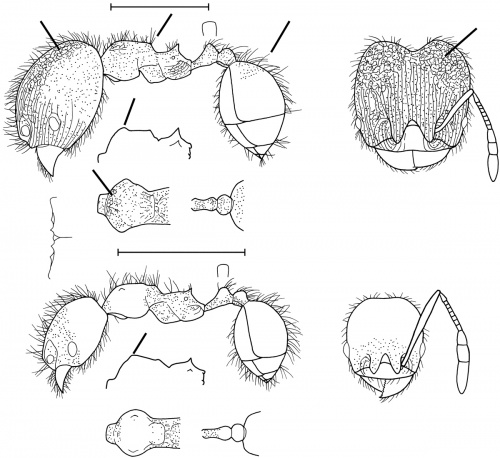Pheidole renae
| Pheidole renae | |
|---|---|

| |
| Scientific classification | |
| Kingdom: | Animalia |
| Phylum: | Arthropoda |
| Class: | Insecta |
| Order: | Hymenoptera |
| Family: | Formicidae |
| Subfamily: | Myrmicinae |
| Tribe: | Attini |
| Genus: | Pheidole |
| Species: | P. renae |
| Binomial name | |
| Pheidole renae Wilson, 2003 | |
Leaf litter in wet forest (Longino 1997).
Identification
See the description in the nomenclature section.
Keys including this Species
Distribution
Mid-elevation Talamancas and Cordillera de Tilaran (Longino 1997).
Latitudinal Distribution Pattern
Latitudinal Range: 10.30976° to 9.4817844°.
| North Temperate |
North Subtropical |
Tropical | South Subtropical |
South Temperate |
- Source: AntMaps
Distribution based on Regional Taxon Lists
Neotropical Region: Costa Rica (type locality).
Distribution based on AntMaps
Distribution based on AntWeb specimens
Check data from AntWeb
Countries Occupied
| Number of countries occupied by this species based on AntWiki Regional Taxon Lists. In general, fewer countries occupied indicates a narrower range, while more countries indicates a more widespread species. |

|
Estimated Abundance
| Relative abundance based on number of AntMaps records per species (this species within the purple bar). Fewer records (to the left) indicates a less abundant/encountered species while more records (to the right) indicates more abundant/encountered species. |

|
Biology
Castes
Nomenclature
The following information is derived from Barry Bolton's Online Catalogue of the Ants of the World.
- renae. Pheidole renae Wilson, 2003: 497, figs. (s.w.) COSTA RICA.
Unless otherwise noted the text for the remainder of this section is reported from the publication that includes the original description.
Description
DIAGNOSIS A distinctive member of the flavens group, separable in the major, by the rugoreticulate occiput and anterior pronotal dorsum, cornulate humerus, steep descent of the posterior mesonotum in profile to the metanotum, and shagreened anterior half of the first gastral tergite. The minor has an obtusely angular humerus in dorsal-oblique view and steep descent of the posterior mesonotal profile. Similar to Pheidole geminata and Pheidole lemnisca.
MEASUREMENTS (mm) Holotype major: HW 1.12, HL 1.12, SL 0.62, EL 0.18, PW 0.54. Paratype minor: HW 0.58, HL 0.60, SL 0.64, EL 0.12, PW 0.36.
COLOR Major: concolorous dark yellow.
Minor: concolorous medium yellow.
Figure. Upper: holotype, major. Lower: paratype, minor. Scale bars = 1 mm.
Type Material
COSTA RICA: Rio Peñas Blancas, Prov. Alajuela, 10°19'N 84°34'W, 800 m, col. J. T. Longino. Museum of Comparative Zoology
Etymology
In honor of my wife and helper Irene (Renee) Wilson.
References
- Wilson, E. O. 2003. Pheidole in the New World: A dominant, hyperdiverse ant genus. Harvard University Press, Cambridge, MA. (page 497, fig. major, minor described)
References based on Global Ant Biodiversity Informatics
- Fernández, F. and S. Sendoya. 2004. Lista de las hormigas neotropicales. Biota Colombiana Volume 5, Number 1.
- Longino J. T. L., and M. G. Branstetter. 2018. The truncated bell: an enigmatic but pervasive elevational diversity pattern in Middle American ants. Ecography 41: 1-12.
- Longino J. et al. ADMAC project. Accessed on March 24th 2017 at https://sites.google.com/site/admacsite/

